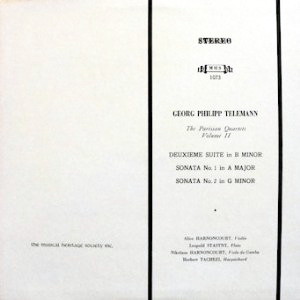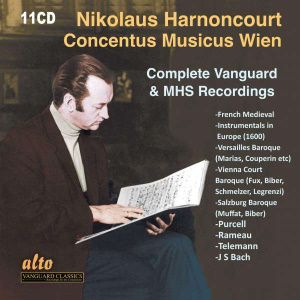 |
1 LP -
MHS 1073 - (p) 1966
|
 |
| 11 LP -
alto ACL 3145 - (p) & (c) 2022 |
|
Georg Philipp
Telemann (1681-1767)
|
|
|
|
|
|
|
|
| The
Parisian Quartets, Volume II |
|
|
|
|
|
|
|
Sonata No. 2 in G minor,
Twv 43: G7
|
|
13' 19" |
|
| - Andante |
3' 50" |
|
A1 |
| - Allegro |
2' 52" |
|
A2 |
| - Largo |
3' 41" |
|
A3 |
| - Allegro |
2' 56" |
|
A4 |
| Deuxieme Suite in B
minor, Twv 43: h1 |
|
13' 09" |
|
| - Prelude |
1' 18" |
|
A5 |
| - Air |
4' 46" |
|
A6 |
| - Rejouissance |
2' 12" |
|
A7 |
| - Courante |
2' 33" |
|
B1 |
| - Passepied |
2' 20" |
|
B2 |
Sonata No. 1 in A Major,
Twv 43: G12
|
|
14' 13" |
|
| - Soave |
4' 41" |
|
B3 |
| - Allegro |
2' 34" |
|
B4 |
| - Andante |
4' 03" |
|
B5 |
| - Vivace |
2' 55" |
|
B6 |
|
|
|
|
| Alice
Harnoncourt, Violin
(Jacobus Stainer, Absam 1658) |
|
| Leopold
Stastny, Flute (A.Grenser,
Dresden, middle of the 18th
century) |
|
| Nikolaus
Harnoncourt, Viola da gamba
(Jacobus Stainer, Absam 1667) and
Director |
|
| Herbert
Tachezi, Harpsichord (copy
of the Italian
instrument circa 1700, by M.
Skowroneck) |
|
|
Luogo e data
di registrazione
|
| Casino Baumgarten, Vienna
(Austria) - 1966 |
|
Registrazione
live / studio
|
| studio |
Producer / Engineer
|
-
|
Prima Edizione
CD |
| alto
- ACL 3145 - (11 lp) - 47' 40" -
(p) & (c) 2022 |
Prima
Edizione LP
|
Musical Heritage Society - MHS
1073 - (1 lp) - 47' 40" - (p) 1966
|
| Note |
| Library of Congress Catalog
No. 70-751714 |
|
|
Notes
|
Telemann's two "Sonatas"
from the six PARIS QUARTETS represent his
attempt to capture the spirit of the
"old-fashioned" Italian sonata da chiesa,
while still writing in the musical
language of his own time. The sonata da
chiesa consisted of four movements,
slow-fast (generally a fugue)-slow-fast
(usually another fugue). Each movement was
usually, but by no means always, related
to the preceding movement by means of a
common rhythmic or melodic motif.
Frequently, all four movements were
related to a motif played at the very
beginning of the work, but which would
undergo slight rhythmic or melodic changes
from movement to mobement.
The "Sonata Seconda" beings with two
themes - one played on the flute, the
other on the violin. after a short pause,
the movement begins again with the two
melodies played on the viola da gamba and
the flute. Following a second short pause,
the movement continues without
interrumption to the end. Despite its
brevity, however, the two or three
distinct melodic fragments upon which the
movement is based recur towards the end in
a kind of abbreviated recapitulation, the
movement being in an experimental, quasi
three-part song form, related to the
emerging preclassical sonata-form. The
fast second movement, like the second
movement of the first sonata, is fugal
without being a fugue. Although it is not
based on any melody from the preceding
movement, rhythmically it is clearly
related to a rhythmic motif played on the
flute at the beginning of the first
movement.
Structurally, the movement is similar to a
movement from a concerto grosso. The tutti
(contrapuntal sections) are set off from
the soli and duets (primarily homophonic
sections). The slow third movement is
again in the concerto grosso style, the
tutti and soli being easily
distinguishable. During the solo sections,
Telemann contrasts the timbre of the flute
and violin, which alternate in playing the
same melodic passages. While there is
little if any melodic or rhythmic
relationschip between the second and
thirdmovement, the third movement is
related melodically to the first and
second - indistinctly, perhaps, but
related nonetheless. An unusual feature of
this movement, which is again in the
nature of a concerto grosso movement, is
the unusual theme which outlines the
dominant ninth chord in ever-widening
melodic leaps.
The fifth and sixth QUARTETS are in the
style of the "modern" French music,
particularly of Couperin. Like the French
composers, Telemann called his works
"Suites." Each movement of these suites is
given a title similar to those found in
the French instrumental music of the
period, and most of them are in the form
of dances.
The "First Suite in G major" begins with a
Prelude closely related in style to
some of the trios of Couperin. The style
of writing in these suites is more in the
a quadro style of the French
chamber music than in the concerto grosso
style of the preceding QUARTETS. The next
movement is a fast French dance, a Rigaudon.
Coincidentally, this Rigaudon is in the
same key as a similar dance by Rameau. It
also makes use of certain melodic and
rhythmic patterns found in Rameau's dance
which was composed in 1724.
The next movement is
called "Air," and because of its
somewhat sad, half-weeping character a
French composer might have called it
"Air Plaintif." The word "Réplique"
means "To answer, to reply, to
retort..." The fourth movement is not a
dance at all, but a kind of galant
character piece in which the flute and
violin play short melodies of two notes
each alternating throughout the movement
while a counter-rhythm is played by the
viola da gamba and continuo. A middle
section to this movement varies the pro
cedure slightly by having both
instruments playing together in thirds
or playing alternate scale passages. The
first of the two Menuets is for
all instruments to play together, while
the second Menuet consists for
the most part of contrasts between the
viola da gamba and continuo, and flute
and violin. The "Suite" closes with a
lively Gigue.
The "Second Suite" opens with all four
instruments playing a lively Prelude.
The following several delicate touches
of the kind of instrumental and harmonic
color one frequently encounters in
French instrumental music. This is
particularly noticeable in the "sighing"
melodies and short unaccompained
passages played near the end of the
second strain by the flute, violin and
viola d gamba in turn.
"Rejouissance" means "rejoicing,
merrymaking," and is one of many such
movements found in Telemann's chamber
and orchestral works. It is interesting
to notice that while many of Telemann's
suites employ the French "Rejouissance,"
the French composers themselves rarely
employed it. The following Courante
is in the French style (the italian Corrente
would of course have been out of place
in this context, even though both Bach
and Handel favored it at this time). The
last movement is a Passepied.
This dance is characterized by what
seems to be a change in meter which
occurs at the end of the first and
second stains. A middle section does not
include this apparent change (the
technical name for this is hemiola)
but instead includes a certain amount of
rhythmic variety missing in the first
section.
Douglas
Townsend
|
|
|
|
Telemann's
Paris QUARTETS for violine,
flute, viola da gamba and
harpsichord are some of his best
and most famous works. He seems
to have had a special fondness
for them, since he made special
mention of them in his
autobiography, which was printed
in 1740 in Mattheson's Ehrenpforte.
The best virtuosi of Paris had
obtained copies of the quartets
and invited Telemann to Paris.
He wrote: "...the admirable
manner in which the Quatuors
were played by the gentlemen
Blavet (cross-flute), Guignon
(violin), Forqueray son (viola
da gamba) deserves to be
descrobed, if this only could be
done by mere words. In short,
they attracted the attention of
the Court and the cuty and
contribuited to the general
esteem in which. I was held
within a short time." These
quartets (of which some are
presented on this record) were
so well received vy Telemann,
while still in Paris, wrote six
more quartets for the same
combination of instruments.
These were published as "Six
Nouveaux Quatuors."
Stylistically, the first six
PARIS QUARTETS consitute a
highly interesting work, since
Telemann demonstrates in them
(in three forms-sonata, suite,
concerto) the prevailing
Italian, French, and German
styles. In spite of this,
however, there is no trace of
any imitation, and the composer
has written in each of the
styles with the sure hand of a
master. As a matter of fact, the
choice of the four solo
instruments is mainly out of
deference to the Franco-German
taste, since at that time the
viola da gamba and the
cross-flute were by no means
popular in Italy, whereas in
Paris they were plainly the
instruments in vogue - togheter
with the violin, which was
coming into fashion. Telemann's
QUARTETS are true soloist music,
in which each of the performers
has to display his full
technical virtuosity as well as
expressiveness in performance,
as each of them is equally
important.
No exact date of composition is
known, but it is assumed these
quartets were written between
1720 and 1730.
Although no autograph score or
parts have yet been found, the
first edition is known to have
been published in 1736 under
Telemann's supervision. It is
this edition which has served as
the basis for the present
recording.
In this recording, only original
instruments were used, i.e., the
violin and the viola da gamba
have the original measurements,
the original bar, especially
made cat gut strings, and are
played with bows dating from the
18th century. The cross-flute,
built by one of the most famous
masters of the 18th century, has
but one key; therefore, all
half-tones are achieved by cross
fingering. Besides the special
sound of the conic boxwood
flute, this has the effect of a
great variety of sound produced
by the individual notes. Thus,
they are given characteristic
features which cannot be
achieved by modern instruments.
The harpsichord is a true copy
of an old one. The strings are
plucked with quills, thus
producing a very clear and
brilliant sound.
The instruments:
- Baroque violin - Jacobus
Stainer, Absam 1658.
- Cross-flute - A. Grenser,
Dresden, middle of the 18th
century.
- Viola da Gamba - Jacobus
Stainer, Absam 1667.
- Harpsichord - copy of an
Italian instrument circa 1700,
by M. Skowroneck, Bremen.
Nikolaus
Harnoncourt
|
|
Nikolaus
Harnoncourt (1929-2016)
|

|

|
|